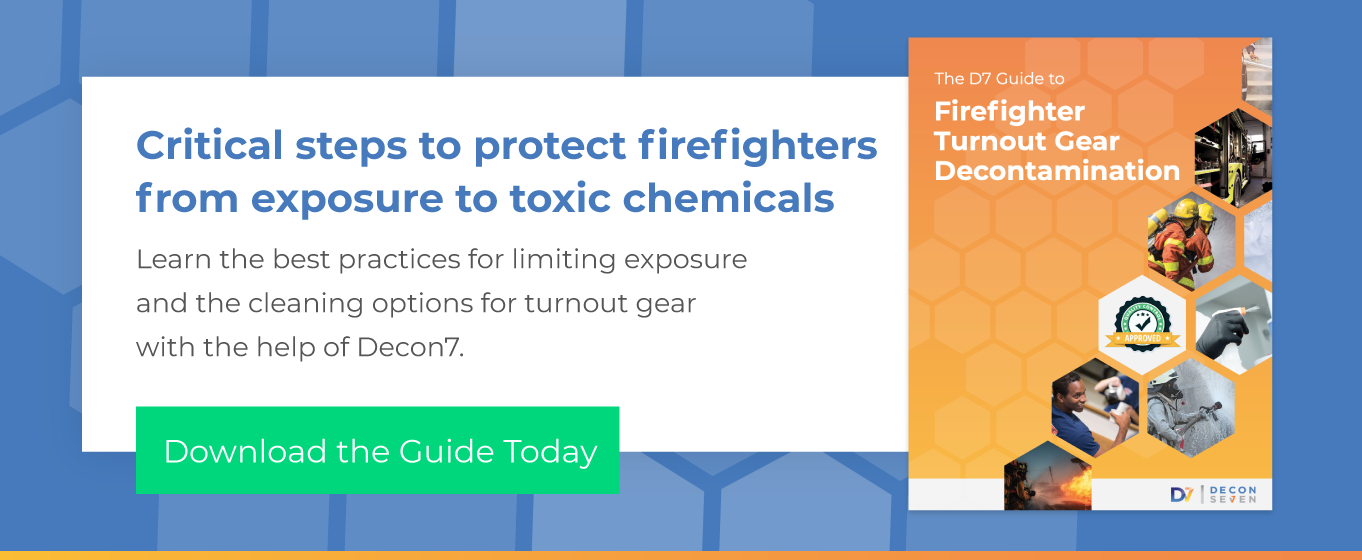
Firefighting is dangerous for obvious reasons, but one of the less obvious risks is exposure to harmful carcinogens. Decontamination on the Fireground of turnout gear and equipment is critical for protecting firefighting professionals from unnecessary exposure to dangerous chemicals. Because of this, turnout gear decontamination should be part of regular training to the extent that it becomes second nature.
Watch video on 5 Steps to Firefighter Turnout Gear Decontamination
The Presence of Carcinogens in Fire
When buildings burn, toxic chemicals are released into the air and collected on surfaces. Some of the toxic compounds from fires include polycyclic aromatic hydrocarbons (PAHs), asbestos, radical aldehydes, VOCs, and hydrogen cyanide. Exposure to these types of chemicals has resulted in the risk of cancer diagnosis for firefighters being 9 percent higher and the risk of cancer death among those diagnosed being 14 percent higher than it is for those who are not in the profession. This represents a significant number of line-of-duty deaths that are due to cancer and not the immediate threats of a fire.
Why Fire Service Decontamination Procedures Are Important
Carcinogens that stay on turnout gear can transfer to the skin and penetrate the body. Toxic chemicals can also transfer from gear to storage or living areas, which is why it’s so important to keep turnout gear separated from other clothing and equipment. Allowing carcinogens to build up on gear only increases the risk, which is why decontamination after every fire event is recommended, especially for gear that touches skin.
It’s important to know that some decontamination procedures slowly degrade materials, which makes them more vulnerable to contamination over time. Scrubbing and high-pressure spraying can also push toxic chemicals deeper into the material, which can prolong exposure and damage equipment.
How to Decontaminate Firefighter Turnout Gear
Because firefighter turnout gear decontamination is so important, understanding how to decontaminate properly is critical for protecting firefighters from unnecessary exposure. Follow these steps for successful decontamination and maintenance of turnout gear:
-
- Choose the right product. Look for a chemical detoxifier that is both effective against toxic chemicals and gentle on materials. A product that is effective with little or no scrubbing is better than one that requires scrubbing. Make sure that the product you choose is proven for use with turnout gear (the manufacturer should be able to provide evidence when asked).
- Apply at the fireground. The sooner you can remove contaminants from turnout gear, the less time firefighters will be exposed. Apply the product as soon as is safe and practical to reduce chemical exposure as much as possible. Make sure the product you choose is easy to transport and apply so that you can do it at the fireground before returning to the station.
- Separate contaminated gear. Any gear or equipment that has been contaminated should be transported separately and stored in a designated area that also gets regularly cleaned to help minimize cross-contamination.
- Launder washable gear. Base layers and other gear that can be laundered should be washed at the station using a chemical detoxifier to remove contaminants before they’re used again.
- Regularly inspect gear. Create a schedule for inspecting gear to ensure that the seams and surfaces maintain their integrity. Make sure firefighters have enough gear so that they can clean sets between use and always have clean gear available.
- Choose the right product. Look for a chemical detoxifier that is both effective against toxic chemicals and gentle on materials. A product that is effective with little or no scrubbing is better than one that requires scrubbing. Make sure that the product you choose is proven for use with turnout gear (the manufacturer should be able to provide evidence when asked).
Use D7 for Turnout Gear Decontamination
D7 is a chemical detoxifier that has proven applications for firefighter turnout gear. Whether applied as a spray, foam, or soak, D7 neutralizes the toxic chemicals typically found in turnout gear without the need for scrubbing. The product was also recently tested according to NFPA 1851 and passed all tests, including semi-volatile organic compound reduction, heavy metal reduction, and biological contamination reduction.
To learn more about the importance of using a chemical detoxifier and how D7 can help, read The D7 Guide to Firefighter Turnout Gear Decontamination.

